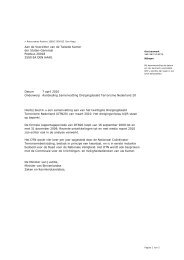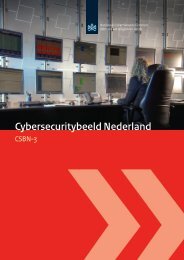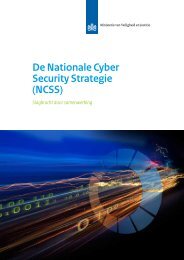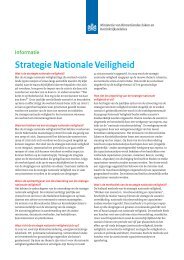third Cyber Security Assessment Netherlands - NCSC
third Cyber Security Assessment Netherlands - NCSC
third Cyber Security Assessment Netherlands - NCSC
You also want an ePaper? Increase the reach of your titles
YUMPU automatically turns print PDFs into web optimized ePapers that Google loves.
tend to unknowingly facilitate this criminal behaviour, but also<br />
‘bulletproof’ providers can be recognized – they are doing so<br />
consciously. In between are companies who operate in the twilight<br />
zone. International virtual payments processors are frequently used<br />
by (high tech) criminals because of the speed and anonymity that<br />
can be achieved.<br />
1.3 Tools used by cyber criminals<br />
During the reporting period, there has been no substantial change<br />
in the way cyber criminals operate. However, criminals are becoming<br />
increasingly aggressive in their actions. One example of this<br />
is ransomware automatically downloading and displaying child<br />
pornography. Botnets remain a popular tool for earning a lot<br />
of money. Malware is increasingly being used to take over computers<br />
completely, reducing the need to use phishing to collect user<br />
credentials. Last year’s CSAN recognised that ransomware plays a key<br />
role in cyber crime targeted directly at end users. Its use increased<br />
significantly during the reporting period, as did the use of encryption<br />
to further thwart law enforcement.<br />
Botnets<br />
Botnets are clusters of infected computer systems which can<br />
be controlled remotely. They are still considered to be the major<br />
element in cyber crime. One important feature is that botnets’<br />
architectures make them particularly difficult to eliminate. See also<br />
the detailed section on botnets for more information, such as how<br />
they work and what happened in recent cases such as Pobelka.<br />
A botnet herder’s business model includes renting their botnet<br />
out for a range of services. For example, botnets consisting of<br />
100,000 bots are available to let for large-scale attacks for a few<br />
hundred U.S. dollars per day.<br />
Malware<br />
A big portion of known malware is targeted at collecting financially<br />
(re)usable data. An important category is made up by banking<br />
trojans, designed to abuse personal users’ internet banking<br />
environments. Generally this malware will attempt to retrieve the<br />
user’s login credentials or to manipulate bank transfers without this<br />
being noticed by the user.<br />
Encryption and cloud<br />
Law enforcement is complicated by the increased use of encryption<br />
on both digital communications and file storage. The<br />
growing popularity of cloud services creates legal as well<br />
as technical challenges, for example raising questions in matters<br />
of (police) jurisdiction.<br />
Ransomware<br />
The spread of so-called ransomware is increasing rapidly. Its<br />
emergence was already highlighted in last year’s report. Ransomware<br />
hijacks the infected system’s functionality, e.g. by encrypting<br />
files or blocking the operating system from working. The malware<br />
then demands a payment from the user to restore the functionality<br />
– which then seldom happens – and puts the user under pressure<br />
not to file a report. Following the first instances in 2009 in Russia<br />
and Eastern Europe, ransomware has now spread to Western<br />
Europe, the United States and many other countries.<br />
More professional ransomware<br />
Ransomware is noteably becoming more professional.<br />
Criminals use encryption and virtual currencies for their<br />
identities to remain concealed. There impact on the victim<br />
is also increasing. Criminals are willing to use any means to<br />
encourage the user to pay and not to file a report with the<br />
police. Examples are: showing police logos, displaying child<br />
pornography and switching on the computer’s webcam so<br />
that the user is shown on-screen. Just like any type of malware,<br />
a ransomware infection can be caught on the regular internet,<br />
under the wrong circumstances. This has a direct impact<br />
on individual citizens’ sense of security, even more so than<br />
hacking, skimming and internet banking fraud.<br />
1.4 Challenges in law enforcement<br />
The dichotomy between high tech crime and ‘regular’ cyber crime<br />
has a big impact on law enforcement. It is therefore highly valuable<br />
to invest in finding and prosecuting the perpetrators of high tech<br />
crime. After all, the impact of this type of cyber crime is manifest.<br />
Furthermore, less knowledgeable attackers adopt these tools and<br />
methods. Of course, improving law enforcement on high tech crime<br />
requires the police to make a relatively big investment in people,<br />
resources and expertise.<br />
In addition to operational limitations, technical complications exist<br />
when it comes to digital research. Criminals’ digital tracks leading<br />
abroad (such as the IP address used) may result in issues of jurisdiction.<br />
Perpetrators are also increasingly using software to completely<br />
conceal their location: one popular example is Tor. A new phenomenon<br />
is that criminal data is increasingly found in the cloud. Koops<br />
[57: WODC 2012]<br />
investigated the consequences of this ‘criminal cloudification’<br />
on law enforcement. He concludes that the development in<br />
itself does not pose new problems, but it is stressing all the existing<br />
legal and technical aspects to the max.<br />
In order to address these problems the Minister of <strong>Security</strong> and<br />
Justice in May 2013 proposed legislation on extending police<br />
capabilities with respect to performing remote investigations on<br />
computers of suspects and, if necessary, to remotely copy data or<br />
render it inaccessible. These competences also allow for situations<br />
where the system’s physical location is unknown.<br />
When combating cyber crime, a problem of a more technical nature<br />
is the use of encryption on both digital communications and file<br />
storage. Nowadays its quality is such that expertly encrypted data<br />
cannot always be decrypted without the owner’s collaboration.<br />
Encryption also poses a problem when investigating seized systems.<br />
In the context of criminal investigations, the police can already<br />
order a <strong>third</strong> party (but not the suspect) to decrypt the inaccessible<br />
56

















